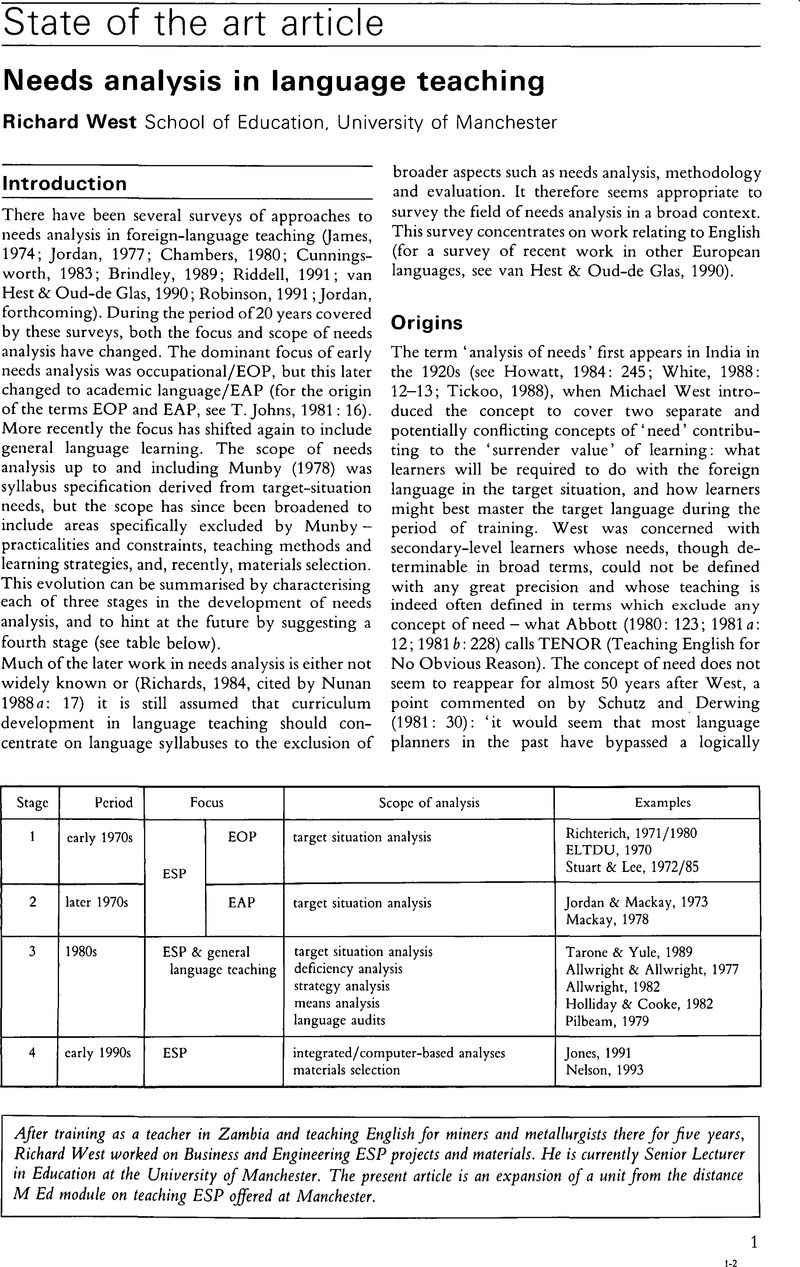Crossref Citations
This article has been cited by the following publications. This list is generated based on data provided by Crossref.
Mémet, Monique
1995.
Content-based instruction in Electrical Engineering: Collecting, organising, and utilising data.
ASp,
Vol. 7-10,
Issue. ,
p.
407.
Sárdi, Csilla
1997.
Needs-based syllabus design for students of English in Hungarian technical universities.
ASp,
Vol. 15-18,
Issue. ,
p.
285.
Jasso-Aguilar, Rebeca
1999.
Sources, Methods and Triangulation in Needs Analysis: a Critical Perspective in a Case Study of Waikiki Hotel Maids.
English for Specific Purposes,
Vol. 18,
Issue. 1,
p.
27.
Braine, George
2001.
When professors don’t cooperate: a critical perspective on EAP research.
English for Specific Purposes,
Vol. 20,
Issue. 3,
p.
293.
Jordan, R.R.
2002.
The growth of EAP in Britain.
Journal of English for Academic Purposes,
Vol. 1,
Issue. 1,
p.
69.
Bosher, Susan
and
Smalkoski, Kari
2002.
From needs analysis to curriculum development.
English for Specific Purposes,
Vol. 21,
Issue. 1,
p.
59.
Kormos, Judit
Kontra, Edit Hegybı́ró
and
Csölle, Anita
2002.
Language wants of English majors in a non-native context.
System,
Vol. 30,
Issue. 4,
p.
517.
Deutch, Yocheved
2003.
Needs analysis for academic legal English courses in Israel: a model of setting priorities.
Journal of English for Academic Purposes,
Vol. 2,
Issue. 2,
p.
125.
Tajino, Akira
James, Robert
and
Kijima, Kyoichi
2005.
Beyond needs analysis: soft systems methodology for meaningful collaboration in EAP course design.
Journal of English for Academic Purposes,
Vol. 4,
Issue. 1,
p.
27.
Madeira, Fábio
2005.
Uma análise dos critérios dos professores na preparação de material didático para cursos de língua estrangeira de conteúdo.
Trabalhos em Linguística Aplicada,
Vol. 44,
Issue. 1,
p.
73.
Jackson, J.
2005.
An inter-university, cross-disciplinary analysis of business education: Perceptions of business faculty in Hong Kong.
English for Specific Purposes,
Vol. 24,
Issue. 3,
p.
293.
Holme, Randal
and
Chalauisaeng, Bussabamintra
2006.
The learner as needs analyst: The use of participatory appraisal in the EAP reading classroom.
English for Specific Purposes,
Vol. 25,
Issue. 4,
p.
403.
Tudor, Ian
2006.
Teacher training and ‘quality’ in higher education language teaching: strategies and options.
European Journal of Teacher Education,
Vol. 29,
Issue. 4,
p.
519.
Davies, Alun
2006.
What do learners really want from their EFL course?.
ELT Journal,
Vol. 60,
Issue. 1,
p.
3.
Hoang Oanh, Duong Thi
2007.
Meeting Students' Needs in Two EAP Programmes in Vietnam and New Zealand.
RELC Journal,
Vol. 38,
Issue. 3,
p.
324.
Cowling, Jeremy David
2007.
Needs analysis: Planning a syllabus for a series of intensive workplace courses at a leading Japanese company.
English for Specific Purposes,
Vol. 26,
Issue. 4,
p.
426.
Bacha, Nahla Nola
and
Bahous, Rima
2008.
Contrasting views of business students’ writing needs in an EFL environment.
English for Specific Purposes,
Vol. 27,
Issue. 1,
p.
74.
Jeong, Cheol-Ja
2009.
Learner Needs Analysis for T&I Program Reform.
Meta,
Vol. 50,
Issue. 4,
Kırkgöz, Yasemin
2009.
Students’ and lecturers’ perceptions of the effectiveness of foreign language instruction in an English-medium university in Turkey.
Teaching in Higher Education,
Vol. 14,
Issue. 1,
p.
81.
Krohn, Nitza
2009.
The Hebrew Language Needs of Future Conservative Rabbis: A Needs Analysis.
Journal of Jewish Education,
Vol. 75,
Issue. 3,
p.
258.



